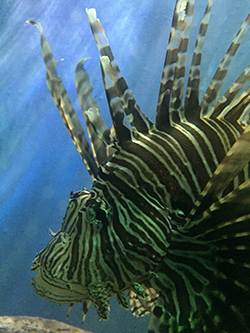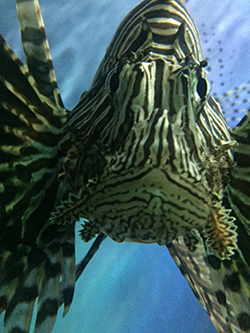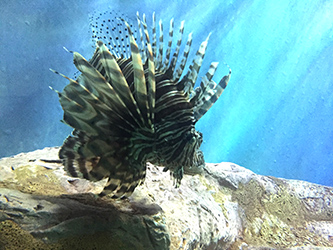Proposal: Robotics to combat Lionfish invasion
Venomous. Voracious. Seemingly unstoppable. The perfect storm among invasive species: Lionfish.
The popular aquarium species, native to the Pacific, has grown from an intentional or inadvertent release of as few as eight females off the Florida coast in the 1980s to a scourge along the eastern seaboard of the U.S., throughout the Caribbean and the Gulf of Mexico. Today, Lionfish threaten to collapse entire reef ecosystems and cause incalculable losses for sport and commercial fisheries.
 Lamar University’s Harley Myler, the William B. and Mary G. Mitchell Endowed Chair in Engineering and chair of the Phillip M. Drayer Department of Electrical Engineering in the College of Engineering, is proposing research to create a semi-automous robotic submersible system capable of working discretely or in concert with others in a swarm to locate, positively identify and remediate the Lionfish outbreak in coastal waters.
Lamar University’s Harley Myler, the William B. and Mary G. Mitchell Endowed Chair in Engineering and chair of the Phillip M. Drayer Department of Electrical Engineering in the College of Engineering, is proposing research to create a semi-automous robotic submersible system capable of working discretely or in concert with others in a swarm to locate, positively identify and remediate the Lionfish outbreak in coastal waters.
“This project will be to develop the robot, recognize the Lionfish, operate in a swarm, work cooperatively with humans and do all this in the marine environment,” Myler said.
It has been described as “the perfect storm” for an invasive species. Able to thrive from the shallows to a depths beyond 400 feet, to go without a meal for 3 months, festooned with venomous spines and lacking natural enemies in the Atlantic, Pterois miles and Pterois volitans, (aka. Devil Firefish, Indian Turkeyfish, Soldier Lionfish, Poisson Scorpion, Lionfish — by any name, trouble. Big trouble.) are creating ecological havoc that is garnering international attention.
 While only growing to about 17 inches and topping out at 2 ½ pounds, the ambush hunters’ outsized impact is the result of a voracious appetite for anything it can swallow whole up to half its size. Fish native to the Atlantic aren’t hardwired to fear them, becoming easy prey. Lionfish can consume up to 80 percent of a reef’s population of small fish in just weeks.
While only growing to about 17 inches and topping out at 2 ½ pounds, the ambush hunters’ outsized impact is the result of a voracious appetite for anything it can swallow whole up to half its size. Fish native to the Atlantic aren’t hardwired to fear them, becoming easy prey. Lionfish can consume up to 80 percent of a reef’s population of small fish in just weeks.
Scientists fear Lionfish will soon dominate the Atlantic ecosystem and eat many ecologically important fish that other fish – including commercially important species like Red Snapper and Grouper – feed on. If you like those on your plate, know that they’re on the Lionfish menu too, and they’ll get them first before they have a chance to grow up. One possible solution: eat the Lionfish first.
Yes, open season on Lionfish. While they have venomous spines, the flesh is safe to consume and tasty. Care must be taken in harvesting and handling, but the resulting fare is becoming more popular. That’s one of the strategies already underway and being promoted by organizations like the National Oceanic and Atmospheric Administration, The Reef Environmental Education Fund, the United States Geological Survey, and the Nonindigenous Aquatic Species Program, working to educate the public on how to remove this invasive species in an effort to help control the population. They also organize lionfish hunts, encourage restaurants to serve Lionfish, set up effective ways to report and track the spread of the species. These efforts, while proving effective, can at best only make a small dent in the apocalyptic population growth resulting from their unbridled reproductive capacity. By just two years of age, Lionfish females can spawn monthly year-round, each female capable of producing over 2 million eggs a year.
Recreation spearfishing for lionfish in shallow water helps some. Because Lionfish depend on their venomous fins for protection they don’t readily flee a threat; it’s less a whac-a-mole and more a “shooting fish in a barrel” experience. Expedition fishing helps as well but trips to known hotspots are expensive. Harvesting a few hundred Lionfish in an outing that could cost thousands of dollars. Dive time is limited – especially at depth where special gasses or long decompression times are required – further limited human effectiveness in tackling the problem. The scourge continues to spread with Lionfish densities reported over 1,000 per acre in some locations.
 In his office in the Cherry Engineering Building, Myler clearly gets jazzed when talking about his latest project — one of many from the prolific thinker — at the intersection of cutting edge robotics research and the kind of pragmatic engineering that is a hallmark of the college that originated to meet the needs of the region’s petrochemical industry.
In his office in the Cherry Engineering Building, Myler clearly gets jazzed when talking about his latest project — one of many from the prolific thinker — at the intersection of cutting edge robotics research and the kind of pragmatic engineering that is a hallmark of the college that originated to meet the needs of the region’s petrochemical industry.
As a member of the Texas State University System’s Texas Invasive Species Institute (TISI), Myler, who holds a Ph.D. in electrical engineering from New Mexico State University, joins with experts in insects and invertebrates, birds, fish, mammals, parasites, reptiles and amphibians, plants, microbes and ecology, as well as Geographic Information Systems and predictive modeling, economics, and engineering. With more than 800 aquatic and terrestrial invasive species identified in Texas, experts predict the trend will continue to increase and TISI will have plenty of work ahead. The cost to Texans already exceeds a billion dollars annually. The TISI website lists the Top 10 invasive species for Texas: the Lionfish isn’t even on it. Yet. It may soon be vying for a top spot.
Using existing technology, Myler’s proposal to the National Science Foundation is to develop semi-automous robotic technology coupled with existing state-of-the-art submersible remotely operated vehicles and then test and refine it through three levels – on campus using models, at Texas Parks and Wildlife Department’s 3,200-gallon saltwater tank in Corpus Christi using live Lionfish in a captive environment, and finally, with National Oceanic and Atmospheric Administration supervision, on Lionfish in varied habitats of the Flower Garden Banks National Marine Sanctuary.
 Myler’s research focus in robotics and machine intelligence leads to his interest in developing robots for species collection and environmental monitoring, either in aquatic or land environments. With the ability to perform their functions autonomously, or semi-autonomously, and for extended periods of time over large areas, he sees great potential for robotics in the mitigation and mediation of invasive species threats. The use of pattern recognition and image analysis algorithms to identify a target species figures prominently in his research experience.
Myler’s research focus in robotics and machine intelligence leads to his interest in developing robots for species collection and environmental monitoring, either in aquatic or land environments. With the ability to perform their functions autonomously, or semi-autonomously, and for extended periods of time over large areas, he sees great potential for robotics in the mitigation and mediation of invasive species threats. The use of pattern recognition and image analysis algorithms to identify a target species figures prominently in his research experience.
His interest in the Lionfish problem originated when he attended a Gulf States Atlantic Region Planning Panel meeting in Raleigh, North Carolina, where he was invited to speak on using robots against invasive species. That interaction led to an invitation from Leslie Hartman, Matagorda Bay Ecosystem Leader of the Texas Parks and Wildlife department, to share his ideas at the first Lone Star Lionfish Symposium at the Harte Research Institute at Texas A&M-Corpus Christi earlier this month.
“The symposium was attended by large number of groups from across the state,” Myler said of the growing interest in tackling the problem. “The presentations, analysis and discussions were very useful in getting a lot of good ideas on the table.”
“Our proposal is to use existing state-of-the-art submersibles to develop and equip intelligent remotely operated vehicles that can be physically tethered to a support vessel for monitoring, control and servicing. Each will be able to identify Lionfish and operate together in a swarm where a single trained operator – a qualified biologist – on the ship can monitor and direct a number of remotely operated vehicles (ROVs) simultaneously,” Myler said.
Myler credits Hassan Zargarzadeh, assistant professor in the department, with suggesting he submit a grant proposal to the National Science Foundation’s National Robotics Initiative that seeks to accelerate Innovative robotics research in the development and use of robots in the U.S. that work beside or cooperatively with people. Three biologists are interested in joining in the grant proposal, Myler said, in part because the system will have the potential to provide valuable information on Lionfish populations.
“These ROV robots will be smart enough not to run into each other, go to and work in specific areas, and avoid the ship’s propellers,” Myler said. “They will know what a Lionfish looks like, and the biologist will be like a dive master monitoring their work. The biologist has the final say.”
Myler’s current proposal does not include how to dispatch the Lionfish. “There are a lot of different ideas on how to destroy the fish,” he said. “First, we have to solve the technical challenges of finding and identifying them, enabling the robot-human interface that will make the system safe, effective and efficient. Deciding the best way to administer the coup de grace will come with time.”


